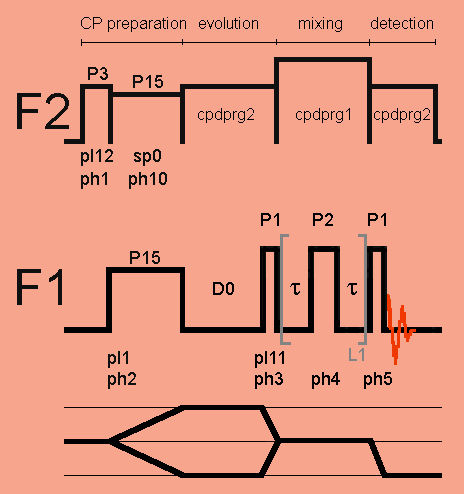
cprfdr: 2D spin diffusion RFDR, CP pulse program for TopSpin2.1

Since non-phase cycling is applied to the preparation pulse (P15), two-phase cycling for the first P1 pulse is applied for filtering SQ coherences, and two-phase cycling is applied to the detection pulse P1 for selecting the 0Q -> -1Q coherence order jump.
Avoid cross-polarization during RFDR excitation.
;cprfdr (TopSpin 2.1)
;2D exchange NMR in rotating solids
;rotor synchronized, set cnst31=spin rate, spin rate regulation
;recommended
;see Bennet, Ok, Griffin, Vega J. Chem. Phys. 98, 8624 (1992)
;written by HF, 16.9.98 modified by HF 21.5.07
;Proton offset at LG frequency during mix to avoid HH transfer
;use TPPI for transform, phases will be dispersive
;Avance III version
;parameters:
;d1 : recycle delay
;d0 : =1u, t1 evolution period
;in0 : = 1/swh{F1}
;pl1 : X power level
;pl11 : power level for X pulses
;sp0 : proton power level during contact
;pl2 : =120dB, not used
;pl12 : power level for H 90 and standard proton decoupling
;pl13 : power level of LG decoupling, 120 dB at high spin rates >15 kHz
;pcpd2 : pulse length in decoupling sequence
;p15 : contact time at pl1 (f1) and pl2 (f2)
;p10 : pulse length for FSLG shape
;p3 : H 90 degree pulse
;p1 : X 90 degree pulse
;p2 : X 180 degree pulse
;cpdprg2 : sequence used for decoupling (tppm15, cw, etc.)
;cpdprg1 : cwlg, using pl13
;spnam0 : file name for variable amplitude CP
;cnst20 : proton RF field to calculate LG parameters
;cnst21 : =0, proton offset
;cnst22 : +ve Lee-Goldburg offset
;cnst23 : -ve Lee-Goldburg offset
;cnst24 : additional Lee-Goldburg offset
;cnst31 : spinning frequency
;l1 : number of rotor cycles for mixing time
;$COMMENT=exchange NMR (RFDR) in rotating solids, rotor synchronized
;$CLASS=Solids
;$DIM=2D
;$TYPE=cross polarisation
;$SUBTYPE=homonuclear correlation
;$OWNER=Bruker
define delay tau
"tau=0.5s/cnst31-p2/2"
"d31=1s/cnst31"
define delay mix
"mix=l1*d31"
;cnst11 : to adjust t=0 for acquisition, if digmod = baseopt
"acqt0=1u*cnst11"
"in0=inf1"
#include <lgcalc.incl>
;calculates the lg offset cnst22 from cnst20=RF field, RF field at pl13
1 ze
#include <rot_prot.incl>
;protect for too slow rotation
#include <p15_prot.incl>
;make sure p15 does not exceed 10 msec
;let supervisor change this pulseprogram if
;more is needed
#include <aq_prot.incl>
;allows max. 50 msec acquisition time, supervisor
;may change to max. 1s at less than 5 % duty cycle
;and reduced decoupling field
mix
d31
2 10m do:f2 :F2 decoupler off
d1 rpp4 ;recycle delay,
;reset the phase ph4 pointer to the first element
2u fq=cnst21:f2
(p3 pl12 ph1):f2 ;proton 90° pulse
(p15 pl1 ph2):f1 (p15:sp0 ph10):f2 ;contact pulse with square or
;ramp shape ramp.100 on F2
d0 cpds2:f2 ;F2 decoupling during evolution: tppm15, or SPINAL64
(p1 pl11 ph3):f1 ;90° pulse putting magnetization back
;to z-axis for RFDR excitation
1u cpds1:f2 ;use cwlg to avoid HH match during mixing period
5 tau ;mixing period with Gullion sequence
;tau = half rotor period - p2/2
(p2 ph4^):f1 ;180° pulse, increment phase ph4 pointer
tau ;tau = half rotor period - p2/2
lo to 5 times l1 ;set l1 for desired mixing period
(p1 ph5):f1 (1u cpds2):f2 ;90° detection pulse,
;F2 decoupling during acquisition
go=2 ph31
1m do:f2 :F2 decoupler off
10m mc #0 to 2 F1PH(ip2,id0)
;delay for disk I/O, store signal,
;increase FID number,
;delete memory data,
;do not perform dummy scans
;with next acquisition,
;increment p2 pulse phase by 90° for TPPI procedure,
;increment time d0 by in0,
;loop to 2, td1 times for 2D experiment
HaltAcqu, 1m
6 exit
ph1= 1 3
ph2= 0
ph3= 0 0 0 0 2 2 2 2
ph4= 0 1 0 1 1 0 1 0 ;X Y X Y Y X Y X compensated echo sequence of Gullion et al.
ph5= 0 0 0 0 0 0 0 0
2 2 2 2 2 2 2 2
ph10=0 0 2 2
ph31=0 2 2 0 2 0 0 2
2 0 0 2 0 2 2 0